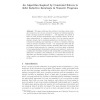Free Online Productivity Tools
i2Speak
i2Symbol
i2OCR
iTex2Img
iWeb2Print
iWeb2Shot
i2Type
iPdf2Split
iPdf2Merge
i2Bopomofo
i2Arabic
i2Style
i2Image
i2PDF
iLatex2Rtf
Sci2ools
ESOP
2016
Springer
2016
Springer
An Algorithm Inspired by Constraint Solvers to Infer Inductive Invariants in Numeric Programs
Abstract. This paper addresses the problem of proving a given invariance property ϕ of a loop in a numeric program, by inferring automatically a stronger inductive invariant ψ. The algorithm we present is based on both abstract interpretation and constraint solving. As in abstract interpretation, it computes the effect of a loop using a numeric domain. As in constraint satisfaction, it works from “above”— ively splitting and tightening a collection of abstract elements until an inductive invariant is found. Our experiments show that the algorithm can find non-linear inductive invariants that cannot normally be obtained using intervals (or octagons), even when classic techniques for increasing abstract-interpretation precision are employed—such as increasing and decreasing iterations with extrapolation, partitioning, and disjunctive completion. The advantage of our work is that because the algorithm uses standard abstract domains, it sidesteps the need to develop complex, no...
| Added | 03 Apr 2016 |
| Updated | 03 Apr 2016 |
| Type | Journal |
| Year | 2016 |
| Where | ESOP |
| Authors | Antoine Miné, Jason Breck, Thomas W. Reps |
Comments (0)

